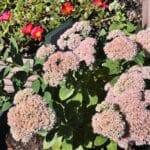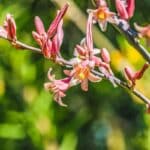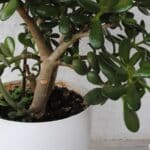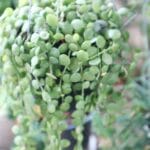Be it in cramped apartments or in spacious greenhouses, grow lights are an increasingly popular trend for succulent growers. These artificial lights made it possible to grow our plants in the safety of our homes without sacrificing their lighting needs.
What Is a Succulent Grow Light?
A grow light, also known as plant light or grow lamp, is not a complicated term. As the name suggests, it is simply a light fixture designed to stimulate plant growth. Compared to regular lights, grow lights emit a full spectrum light, which means it contains ultraviolet light, infrared light, and photosynthetically active radiation (PAR). (1)
If you are a succulent collector, you might come to the point where you consider having a grow light for your plants. Succulents do not necessarily require grow lights. They can go by with just natural sunlight.
However, if you really want to learn how to take care of succulents, understanding the lighting needs for your indoor succulents is very necessary.
For instance when there is limited natural light, i.e. in winter when day length is shorter or your living space does not have enough light, it can be a good thing to have a grow light in hand. Grow lights can also help if you want to stimulate better growth and even flowering indoors.
How to Choose The Best Grow Lights for Succulents
There are several factors that you must look for in a grow light. Each of these factors will affect the growth and development of your succulents. (1,2)
Light Output
Light output refers to how bright and powerful a grow light is. Measured in lumens, this factor will determine the amount of light your plants can get, and how they will grow.
Although popular as succulents indoors because of their ability to tolerate shade, succulents still require bright light to achieve the best growth. A grow light that emits at least 2000 lumens per square foot is best for growing succulents.
Spectrum
Plants perceive light based on its wavelength or spectrum. They mainly use the wavelength between 350-800 nm. There are three types of light in this spectrum and each of them triggers certain responses from plants. These are ultraviolet (UV) light, infrared (IR) light, and photosynthetically active radiation (PAR).
Ultraviolet light is the spectrum of light between 350-400nm wavelength and the one responsible for the reddish tinge in sun-soaked succulents. Infrared light, on the other hand, is on the other end of the spectrum.
At 700-800nm wavelength, infrared light induces flowering. In between UV light and infrared lights is the photosynthetically active radiation (PAR). This is the light that plants use for photosynthesis.
Grow lights can come in varying amounts of these wavelengths. A full spectrum white light is best for succulents as it will contain a balanced amount of these lights. But really, it would depend on what kind of response you want to trigger in your plants.
Amount of Usable Light
Usable light refers to the photosynthetically active radiation (PAR) which is utilized by plants. This is the light that we can see that when passed through a prism, contains the rainbow colors. Among these colors, the red and blue are the ones used by plants for photosynthesis while green is reflected, giving the plants its luscious color.
For grow lights, the brighter the light it emits, the greater the amount of PAR available for your succulents.
Light Color Temperature
Measured in Kelvin (K), this refers to how cool or how warm a grow light is. This depends on the amount of blue and red light the bulb emits. Grow lights can come with either a bluish (cool) or a yellowish (warm) color. These colors can stimulate different responses in your succulents.
Succulents prefer color temperatures between 3000K to 6000K. If you want to stimulate growth, a cooler light at 6500K temperature is best. On the other hand, if you want to stimulate flowering, you should opt for a warmer light at 3000K.
Efficiency
Grow light efficiency will depend on how much of the electric energy is converted into light energy and how much heat is produced. Measured in percentage, different types of grow light have different efficiencies.
When choosing one for your succulents, choose a more efficient light that generates bright light while using less energy. Choose one that also generates less heat not only because it is energy wasted but it can also cause damage to your plants.
Number of Hours
Another factor to consider is the number of hours you are going to expose your succulents. You do not have to leave your grow light on all the time because plants, especially the members of Crassulaceae, also need the dark for some of their physiological processes.
As a rule, you must expose your plants 12-14 hours a day. Take this into consideration because some grow lights can lose their brightness with time.
What are the Different Types of Grow Lights?
There are many types of grow lights available for indoor plants. Each of them varies from one another based on the factors mentioned above. You can choose from this wide array of lights depending on the kind of response you want to get from your plants.
Incandescent Light
First time growers and those who only require light sources for a single plant often go for incandescent grow lights. It is a low intensity light that emits a warm, yellowish glow. While it is relatively cheap and can keep your plant growing, this type of grow light is the least efficient option.
Incandescent bulbs have a low usable light output and a high heat output which is evident if you touch the bulb. Incandescent bulbs are also designed for spotlight fixtures, so if you have a larger collection, you will certainly need more bulbs (1,3).
Fluorescent Light
This is the most popular grow light for succulents because of its efficiency and ability to cover large collections with just a single bulb. The light it emits is a full spectrum white light, the perfect light for succulents.
Fluorescent lights are more efficient than incandescent lights, producing 2-3x light and lesser heat. It also comes in different sizes.
As mentioned, it can cover a bigger area but if you only need it for a smaller collection, a compact fluorescent light (CFL) is also available with the same efficiency and light spectrum. The only downside for this type of light is that its light deteriorates with age (1,3).
LED
LEDs are relatively new. They are full spectrum lights and compared to incandescent and fluorescent lights, they are more natural looking. They are also more efficient and more affordable (1).
LEDs can come in small scale fixtures to larger, HPS-que rigs.
High Pressure Sodium (HPS)
Compared to the previous lights, HPS is a high intensity lighting. HPS bulbs emit a very bright, yellowish light, akin to streetlamps. The yellow color of this light makes it perfect for inducing flowering in plants. HPS bulbs are also very efficient and long lived. The only downside is its deficiency in blue light which results in thin and lanky plants. This is why HPS light is more applicable for greenhouses as a supplemental lighting for natural sunlight (2,3).
Metal Halide (MH)
Metal Halide is another high intensity lighting. Compared to HPS, this light emits a bluer light and has a spectrum similar to natural sunlight which means it can produce UV light, but it is not as efficient as HPS. The cooler temperature of this light makes it perfect for inducing green, leafy growth.
The efficiency of MH is like that of a fluorescent light except on a larger scale. Proper caution should be observed with this grow light as it can explode if installed incorrectly or if it comes in contact with water (2,3).
How to Set Up a Grow Light
When setting up a grow light for your succulents you must first consider the size of your collection, the type of succulent you are growing, and how you want your plants to grow. Knowing the size of your collection will help you determine the number of bulbs you will need while knowing the type of succulent and how you want it to grow will help you to decide what type of grow light to use.
Select a space in your home where your set-up will be safe. Grow lights should be set up from above to simulate natural light. A rough guide for light placement is that incandescent bulbs should be placed 24 inches above the plant as it generates more heat while fluorescent bulbs and LEDs can be placed at 12 to 6 inches (4). High intensity lights such as HSDs and MHs will require a higher placement.
Do not forget to set an interval of light exposure and dark. It is also important to change the position of the grow lights with regards to the growth of your plants.
If you have problems in setting up your grow light, do not hesitate to contact the manufacturer for specifics and directions.
FAQs
Can succulents survive in artificial light?
Yes, succulents can survive in artificial light, but they typically thrive best with adequate natural light supplemented by artificial light if needed.
What type of light do succulents like?
Succulents prefer bright, indirect sunlight. They can tolerate some direct sunlight, but intense, prolonged exposure may cause sunburn or leaf damage.
What color LED light for succulents?
Succulents benefit from LED (light emitting diode) grow lights with a color temperature between 5000K and 6500K, which provides a balance of blue and red light that mimics natural sunlight.
How bright should grow lights be for succulents?
Grow lights for succulents should be relatively bright, with an intensity of at least 2000 lumens per square foot. Adjust the height and duration of light exposure based on the specific needs of your succulents and the type of grow light used.
How often do you water succulents under grow lights?
The frequency of watering succulents under grow lights depends on factors such as the type of succulent, the intensity of light, and the humidity levels. In general, water succulents when the soil feels dry several inches below the surface, and adjust watering frequency as needed based on environmental conditions and plant response.
See more: How to grow succulent plants
References
Reference list
(1) Halleck L.F. “Gardening Under Lights: The Complete Guide for Indoor Growers”. Timber Press. 2018. PP 11-87.
(2) Smith S. “Greenhouse Gardener’s Companion: Growing Food and Flowers in Your Greenhouse Or Sunspace”. Fulcrum Publishing 2000. PP 17-21.
(3) “Indoor Plant Grow Light Guide”. ACS Greenhouses. Aarons Creek Farms Inc.
(4) Old Farmer’s Almanac. “The Old Farmer’s Almanac Vegetable Gardener’s Handbook”. Houghton Mifflin Harcourt. 2019. PP 199-201.
Close







